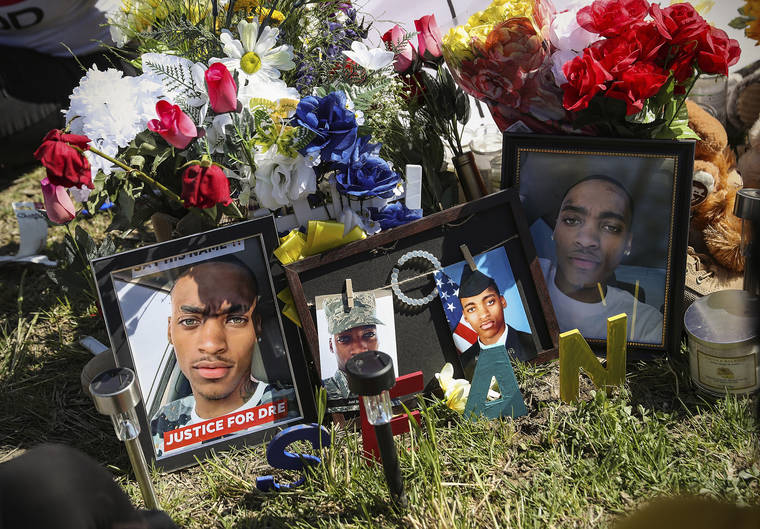INDIANAPOLIS — Attorneys for the family of a 21-year-old Black man who was shot and killed in May by an Indianapolis police officer blasted the investigation on Saturday, saying a more thorough one could have led the grand jury to return a criminal indictment against the officer.
The lawyers for Dreasjon Reed’s family maintain that at least 10 eyewitnesses saw Officer Dejoure Mercer shoot Reed with his stun gun and then repeatedly with his firearm while Reed lay writhing on the ground. Contrary to findings of a State Police investigation, those witnesses maintain that Reed didn’t fire on the officer, the lawyers said.
“Their testimony was consistent — Dreasjon was tased, he fell, he was shot while still shaking on the ground. He did not shoot back,” attorney Fatima Johnson said during an online news conference Saturday. She said she was “beyond disgusted” that Mercer won’t face charges — at one point repeating the word “again” 13 times to represent how many times Mercer fired at Reed.
“Dejoure Mercer did not stop shooting until Dreasjon stopped moving, until Dreasjon stopped breathing, until his life was gone and he was not here anymore,” Johnson said.
Reed’s May 6 shooting was not recorded on video because the police department only began implementing a body camera program in August. But Reed livestreamed an earlier car chase and part of a foot chase on Facebook.
Special prosecutor Rosemary Khoury, who was appointed in June to oversee the investigation into the shooting, announced Tuesday that the grand jury had declined to indict Mercer, who is also Black. She said the grand jurors found there was insufficient evidence to indict or accuse Mercer of a crime but that she couldn’t discuss what evidence was presented because grand jury proceedings are secret.
Swaray Conteh, another Reed family attorney, said Saturday that the public should be skeptical of the investigation, which was conducted by the Indiana State Police.
“It was a very shallow piece of work and Officer Mercer should’ve been indicted and had the opportunity to prove his innocence in court,” Conteh said.
Indiana State Police spokesman Capt. Ron Galaviz defended the agency’s investigation.
“While we can’t imagine what this family is enduring, we stand by our objective conclusions,” Galaviz said.
Reed’s mother, Demetree Wynn, filed a federal wrongful death lawsuit in June against the city, its police department and four officers, including Mercer. That suit alleges the department failed to adequately train, screen and supervise officers to prevent them from engaging in excessive or deadly force.
Conteh said Saturday that the family would now concentrate on the lawsuit rather than pressing for a federal civil rights investigation.
Mercer’s attorney, John Kautzman, said he always believed the evidence proved that Mercer was justified in defending himself. He said he believes the State Police conducted a thorough investigation and that there was strong evidence that Reed fired his handgun during the confrontation. He said the grand jury would have heard from those eyewitnesses and considered their testimony.
“We believe the grand jury properly evaluated all the evidence based on all the information that I presume was provided to them by the state police investigation,” Kautzman said.
The Indianapolis Police Department and the city attorney’s office declined to comment.
Days of protests followed Reed’s killing and about 50 people briefly blocked some city streets Saturday afternoon as they marched to a district police headquarters.
In Reed’s shooting, the Indianapolis Metropolitan Police Department said officers began pursuing him after they saw someone driving recklessly on Interstate 65. Supervisors ordered an end to that pursuit because the vehicle was going at nearly 90 mph (145 kph), police said. Mercer later spotted the same car on a city street and chased Reed on foot before, police say, the two exchanged gunfire.
State Police Detective David Herron said Tuesday the evidence the agency reviewed showed that Reed fired two shots from his handgun and Mercer fired 13 shots, although investigators were not able to determine who shot first.
That evidence included video from Reed’s cellphone and surveillance video from exterior cameras of a nearby business. The video shows Reed running from Mercer before falling face first to the ground.
Herron showed still images from the cellphone video that he said show an orange portion of the butt of the magazine of Reed’s handgun and of Reed drawing the weapon. He said that it appears Mercer first used a stun gun but that Reed was not incapacitated by the two electric probes that struck him.




